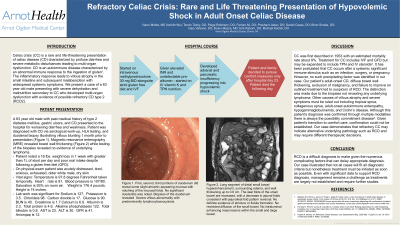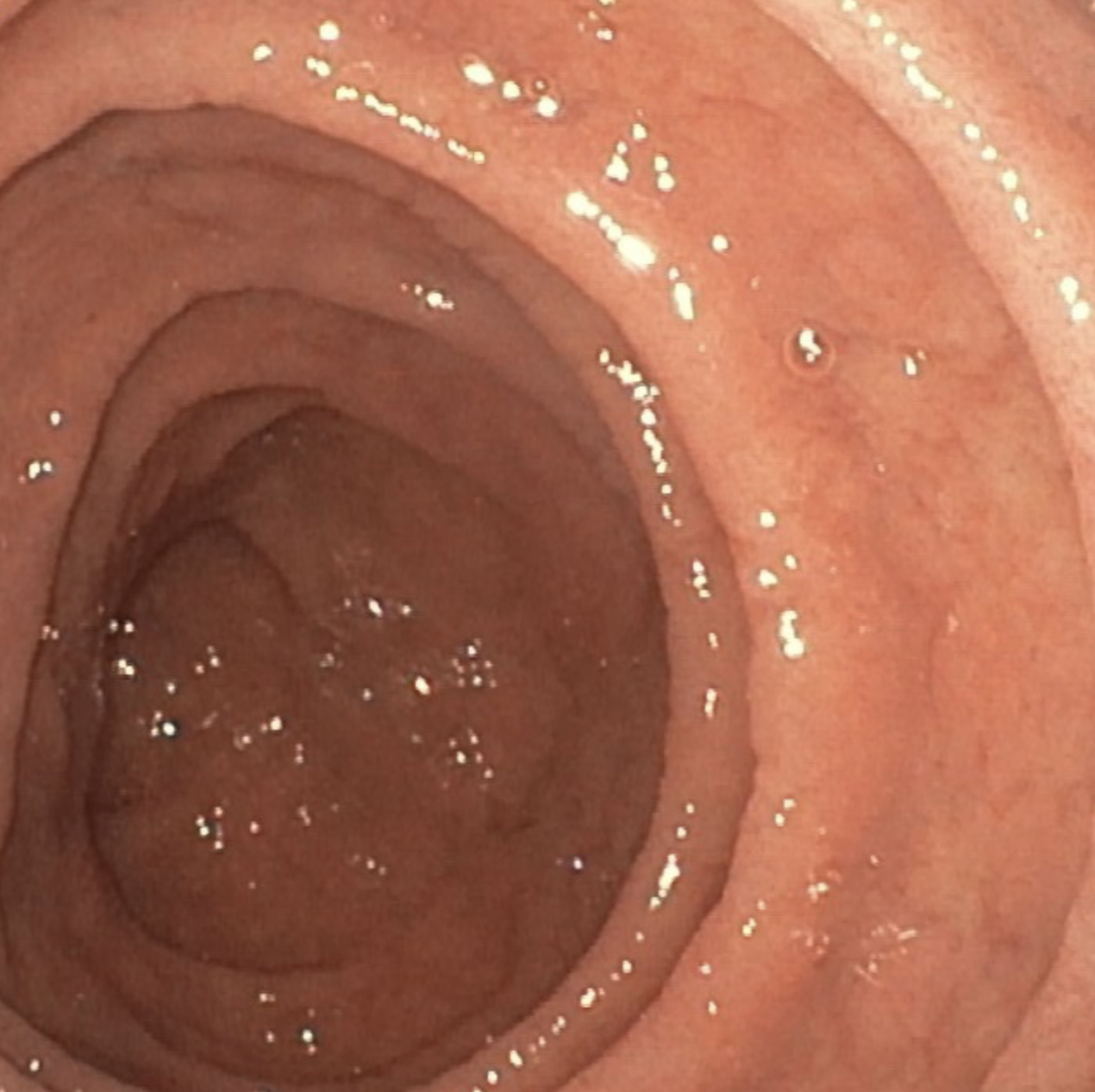Sunday Poster Session
Category: Small Intestine
P1531 - Refractory Celiac Crisis: Rare and Life Threatening Presentation of Hypovolemic Shock in Adult Onset Celiac Disease
Sunday, October 27, 2024
3:30 PM - 7:00 PM ET
Location: Exhibit Hall E

Has Audio
- VM
Varun Mehta, MD
Arnot Ogden Medical Center
West Elmira, NY
Presenting Author(s)
Varun Mehta, MD1, Tenzin Tseky, DO2, Paige Robinson, DO2, Farhan Ali, DO2, Prashant Jadav, DO2, Daniel Casas, DO2, Brian Sowka, DO2, Gary Valvano, DO2, Bruno Mazza, MD2, Erik Raborn, DO2, Michael Kochik, DO2
1Arnot Ogden Medical Center, West Elmira, NY; 2Arnot Ogden Medical Center, Elmira, NY
Introduction: Celiac crisis (CC) is a rare and life-threatening presentation of celiac disease (CD) characterized by profuse diarrhea and severe metabolic disturbances leading to multi-organ dysfunction. CD is an autoimmune disease characterized by an abnormal immune response to the ingestion of gluten. The inflammatory response leads to villous atrophy in the small intestine and subsequent malabsorption with widespread systemic symptoms. We present a case of a 63 year old male presenting with severe dehydration and malnutrition secondary to CC who developed multi-organ dysfunction with evidence of possible refractory CD type 2 (RCD2).
Case Description/Methods: A 63 year old male with past medical history of type 2 diabetes mellitus, gastric ulcers, and CD presented to the hospital for worsening diarrhea and weakness. Patient was diagnosed with CD via serological work-up, HLA testing, and duodenal biopsy illustrating villous blunting 1 month prior to presentation. Magnetic resonance enterography (MRE) revealed bowel wall thickening while testing of the biopsies revealed no evidence of underlying lymphoma. Patient noted a 16 lbs. weight loss in 1 week with greater than 1L of stool per day and poor oral intake despite following a gluten free diet (GFD). Lab work was significant for sodium 127, potassium 3.5, carbon dioxide 17, BUN 40, creatinine 1.7, calcium 6.9, and albumin 2.3. Patient was started on intravenous (IV) steroids, total parenteral nutrition (TPN), intravenous fluids (IVF), and strict GFD. Patient developed adrenal and pancreatic insufficiency progressing into hypovolemic shock complicated by worsening kidney function. Patient ultimately decided to transition to comfort measures and died in the hospital.
Discussion: CC was first described in 1953 with an estimated mortality rate about 9%. Treatment for CC includes IVF and GFD but may be expanded to include TPN and IV steroids. It has been postulated that CC occurs after a systemic significant immune stimulus such as an infection, surgery, or pregnancy. However, no such precipitating factor was identified in our case. Our patient’s adult-onset CD, diffuse bowel wall thickening, exclusion of malignancy, and failure to improve on outlined treatment led to suspicion of RCD2. Given patient’s transition to comfort care, confirmation could not be established. Our case demonstrates that refractory CC may indicate alternative underlying pathology such as RCD2 and may require different therapeutic decisions.

Disclosures:
Varun Mehta, MD1, Tenzin Tseky, DO2, Paige Robinson, DO2, Farhan Ali, DO2, Prashant Jadav, DO2, Daniel Casas, DO2, Brian Sowka, DO2, Gary Valvano, DO2, Bruno Mazza, MD2, Erik Raborn, DO2, Michael Kochik, DO2. P1531 - Refractory Celiac Crisis: Rare and Life Threatening Presentation of Hypovolemic Shock in Adult Onset Celiac Disease, ACG 2024 Annual Scientific Meeting Abstracts. Philadelphia, PA: American College of Gastroenterology.
1Arnot Ogden Medical Center, West Elmira, NY; 2Arnot Ogden Medical Center, Elmira, NY
Introduction: Celiac crisis (CC) is a rare and life-threatening presentation of celiac disease (CD) characterized by profuse diarrhea and severe metabolic disturbances leading to multi-organ dysfunction. CD is an autoimmune disease characterized by an abnormal immune response to the ingestion of gluten. The inflammatory response leads to villous atrophy in the small intestine and subsequent malabsorption with widespread systemic symptoms. We present a case of a 63 year old male presenting with severe dehydration and malnutrition secondary to CC who developed multi-organ dysfunction with evidence of possible refractory CD type 2 (RCD2).
Case Description/Methods: A 63 year old male with past medical history of type 2 diabetes mellitus, gastric ulcers, and CD presented to the hospital for worsening diarrhea and weakness. Patient was diagnosed with CD via serological work-up, HLA testing, and duodenal biopsy illustrating villous blunting 1 month prior to presentation. Magnetic resonance enterography (MRE) revealed bowel wall thickening while testing of the biopsies revealed no evidence of underlying lymphoma. Patient noted a 16 lbs. weight loss in 1 week with greater than 1L of stool per day and poor oral intake despite following a gluten free diet (GFD). Lab work was significant for sodium 127, potassium 3.5, carbon dioxide 17, BUN 40, creatinine 1.7, calcium 6.9, and albumin 2.3. Patient was started on intravenous (IV) steroids, total parenteral nutrition (TPN), intravenous fluids (IVF), and strict GFD. Patient developed adrenal and pancreatic insufficiency progressing into hypovolemic shock complicated by worsening kidney function. Patient ultimately decided to transition to comfort measures and died in the hospital.
Discussion: CC was first described in 1953 with an estimated mortality rate about 9%. Treatment for CC includes IVF and GFD but may be expanded to include TPN and IV steroids. It has been postulated that CC occurs after a systemic significant immune stimulus such as an infection, surgery, or pregnancy. However, no such precipitating factor was identified in our case. Our patient’s adult-onset CD, diffuse bowel wall thickening, exclusion of malignancy, and failure to improve on outlined treatment led to suspicion of RCD2. Given patient’s transition to comfort care, confirmation could not be established. Our case demonstrates that refractory CC may indicate alternative underlying pathology such as RCD2 and may require different therapeutic decisions.

Figure: Atrophic appearing duodenal mucosa with notching consistent with celiac disease
Disclosures:
Varun Mehta indicated no relevant financial relationships.
Tenzin Tseky indicated no relevant financial relationships.
Paige Robinson indicated no relevant financial relationships.
Farhan Ali indicated no relevant financial relationships.
Prashant Jadav indicated no relevant financial relationships.
Daniel Casas indicated no relevant financial relationships.
Brian Sowka indicated no relevant financial relationships.
Gary Valvano indicated no relevant financial relationships.
Bruno Mazza indicated no relevant financial relationships.
Erik Raborn indicated no relevant financial relationships.
Michael Kochik indicated no relevant financial relationships.
Varun Mehta, MD1, Tenzin Tseky, DO2, Paige Robinson, DO2, Farhan Ali, DO2, Prashant Jadav, DO2, Daniel Casas, DO2, Brian Sowka, DO2, Gary Valvano, DO2, Bruno Mazza, MD2, Erik Raborn, DO2, Michael Kochik, DO2. P1531 - Refractory Celiac Crisis: Rare and Life Threatening Presentation of Hypovolemic Shock in Adult Onset Celiac Disease, ACG 2024 Annual Scientific Meeting Abstracts. Philadelphia, PA: American College of Gastroenterology.
